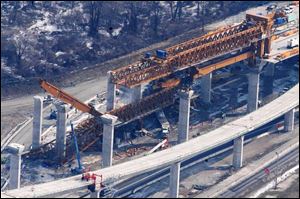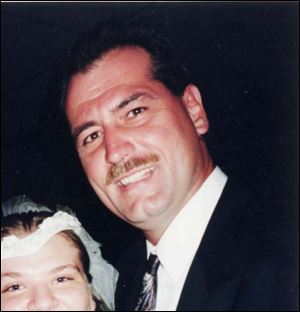
Crane collapse in 2004 claimed 4 lives; another worker died in April accident
6/17/2007
Mike Phillips
lisa dutton copy photo / family photo

On Feb. 16, 2004, a huge gantry truss crane peeled away and crashed 60 feet to the ground.
Robert Lipinski, Sr., a retired ironworker in Swanton, is almost done with the restoration of his 1937 Buick, a car he bought for $25 in 1957 that will soon be an automotive gem.
"Now, it just needs a good coat of paint," said Mr. Lipinski, who was an ironworker for 30 years.
He s putting the finishing touches on the old car by himself. His son, Robert Lipinski, Jr., was going to help him on the project, but he died in February, 2004, when a huge crane collapsed during construction of the Veterans Glass City Skyway bridge across the Maumee River near downtown Toledo.

Robert Lipinski, Jr.
"I miss him terribly," said the elder Mr. Lipinski. He said his son, an ironworker for 24 of his 44 years, would have been very proud of his contribution to the magnificent new bridge. "It s a shame he won t be there for the opening [next weekend]."
Nicole Moreau of Petersburg still finds it difficult to talk about her son, Mike Moreau, who was only 30 when he died in the same accident.
"It s very hard," she said.
But she and her husband, Paul, a retired ironworker, are coping with the tragedy "one day at a time." Her son also would have been proud of his role in the bridge s construction.
The crane collapse on Feb. 16, 2004, also killed Mike Phillips, 42, and Arden Clark II, 47, and injured four other workers. Another accident two months ago killed a carpenter, 36-year-old Andrew Burris, who fell from a construction platform.
Those accidents and other construction mishaps contributed to delays in the $220 million bridge project that is a new path for I-280 and cost the contractors hundreds of thousands of dollars in federal fines and payments of more than $11 million to families and estates of those killed.
They tarnished the safety record of the main contractor, Fru-Con Construction Corp. of Ballwin, Mo.
Lucas County prosecutors and Toledo police officers are investigating the 2004 tragedy that could result in criminal charges against contractors or the manufacturer of the crane that collapsed.
"We re still in the process of trying to decide whether to bring charges or not," Prosecutor Julia Bates said. The investigation has been hampered because the Italian crane maker, Paolo de Nicola SpA, is in receivership and local officials don t speak Italian.
Early in the project, in March, 2003, Fru-Con, labor unions, and government agencies joined in what was billed as a historic partnership to ensure safety. The agreement established a safety committee representing those dozen groups, and it called for "voluntary efforts to improve safety and health" instead of traditional enforcement by the U.S. Labor Department s Occupational Safety and Health Administration.
The pact promised "an unparalleled training and safety effort to ensure that the bridge s construction is among the safest in America s history."
That was welcome news to many workers, painfully aware that large bridge projects often produce numerous deaths and injuries. For example, dozens of workers died during construction of the Brooklyn Bridge, five died building Michigan s Mackinac Bridge, and 11 were killed during construction of San Francisco s Golden Gate Bridge.
But the deaths in early 2004 brought the partnership into question.

Mike Phillips
During the ensuing investigation, OSHA terminated the partnership agreement and in July, 2004, cited Fru-Con for "willful" safety violations, including improperly anchoring the massive cranes that weighed 1.8 million pounds each and for failing to follow warnings issued by the crane manufacturer.
Officials also were disturbed that Fru-Con did not inform the partnership committee of the crane problems.
In May, 2005, Fru-Con agreed to pay the $280,000 in return for getting the violations changed from the most serious "willful" category to "unclassified."
"The partnership was not as successful as we had hoped," said Jule Hovi, OSHA director for this area.
For such a safety agreement to work, she said recently, "All the partners have to communicate in every way, and that did not happen Employees need to be protected, and manufacturers guidelines need to be followed."
Joe Blaze II, business agent for Local 55 of the Ironworkers union, was a member of the partnership s safety committee. He and some survivors of the men who died were displeased with the safety agency s decision to downgrade the severity of the penalties.
Mr. Blaze declined to be interviewed for this story, saying there has been enough comment on the tragedy.

Arden Clark
But two years ago, months after the crane collapse, he told The Blade he was "flabbergasted" by the OSHA decision. At that time, he said he had no reason to doubt Fru-Con s sincerity. But said he was "very, very upset" when Blade reporters showed him e-mails and memos from the crane manufacturer warning of potential collapse unless certain precautions were taken.
At that time, Fru-Con issued a statement saying it never saw a need to share concerns about the cranes with the safety committee because it believed the problems had been corrected.
U.S. Rep. Marcy Kaptur (D., Toledo), who initially was optimistic the safety partnership would save lives, later said the deaths were preventable and she asked for federal help in the investigation being done by Toledo police and Lucas County prosecutors.

Despite the deaths, OSHA has high hopes for safety partnerships, said Brad Mitchell, an agency spokesman.
More than 440 have been approved in the last nine years and rarely have they been terminated, he said. One other one in the Midwest that was terminated involved a large Chicago building, he said. The agreement was reinstated later.
The Toledo crane collapse led to a lawsuit that is still pending in U.S. District Court in Toledo. Fru-Con sued the crane maker, Paolo de Nicola, alleging the Italian company did not properly design the cranes, costing nearly $6 million, for the curvature of the bridge. It claimed that shipments of components were three months late and assembly of the cranes each about as long as a football field was delayed six months.
Damages sought in the lawsuit are so far unspecified.
The timetable for the big bridge has changed several times. It was originally scheduled to be completed in late 2006, but when construction was going well, a fall 2005 date was set.
The actual opening next weekend is about eight months later than the original projection.

As for the Toledo and Lucas County investigation, Ms. Bates said about $60,000 has been spent so far, mostly by the city of Toledo, including the hiring of a California engineering firm to review documents.
John Weglian, chief of the special units division of the prosecutor s office, said the statute of limitations for such felony charges as involuntary manslaughter or reckless homicide is six years, which would extend to 2010.
"It s a question of if and when," said Mr. Weglian. He doesn t anticipate charges before next year.
David Dysard, the Ohio Department of Transportation s new deputy director in Bowling Green, said he isn t soured on safety partnerships despite the failure of the one involving Fru-Con.
"It is an inherently dangerous business, and that s the bottom-line reality of it," he said. "We do need all the safety regulations The first thing we think about is safety."
Contact Homer Brickey at: homerbrickey@theblade.com or 419-724-6129.